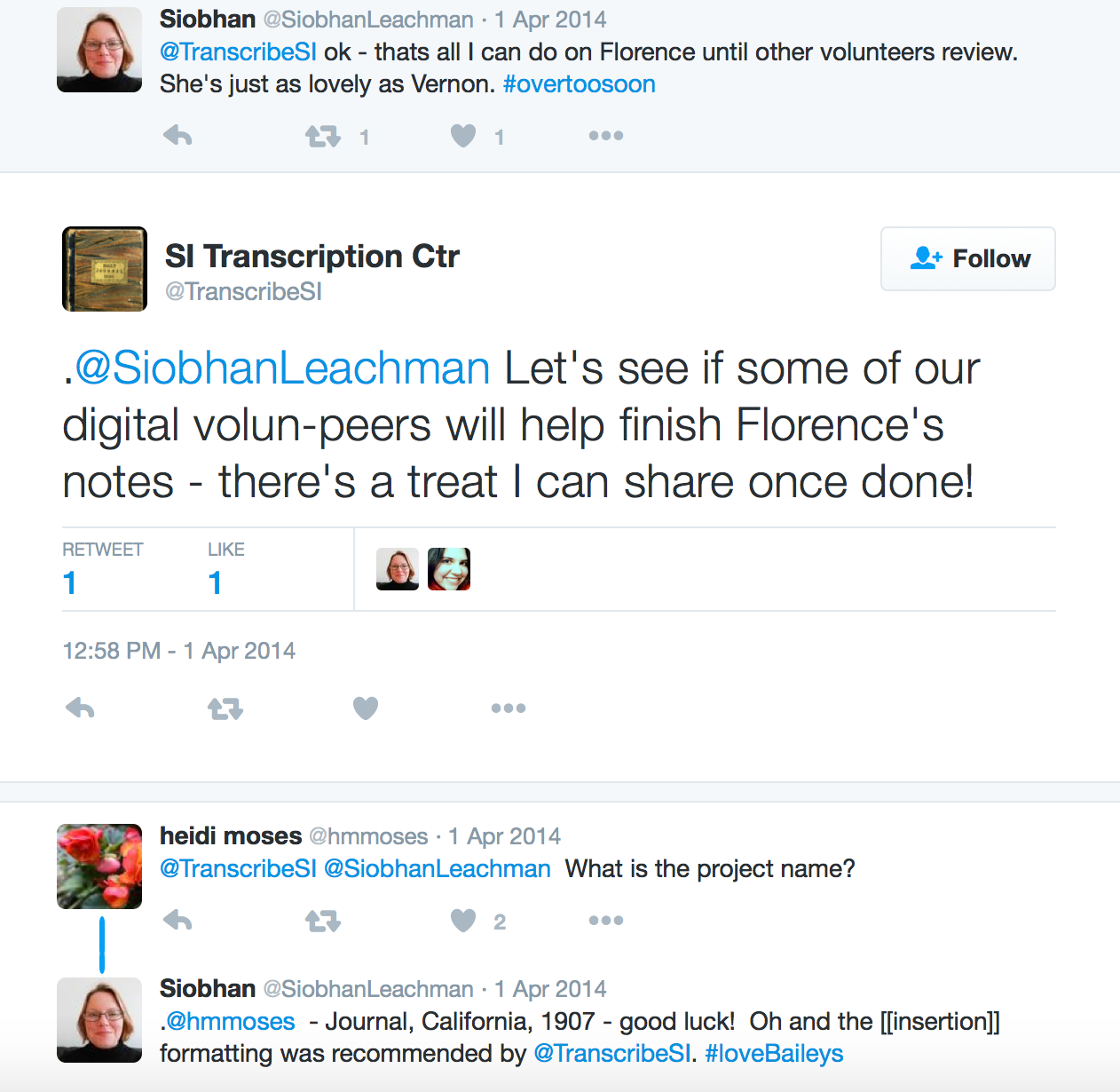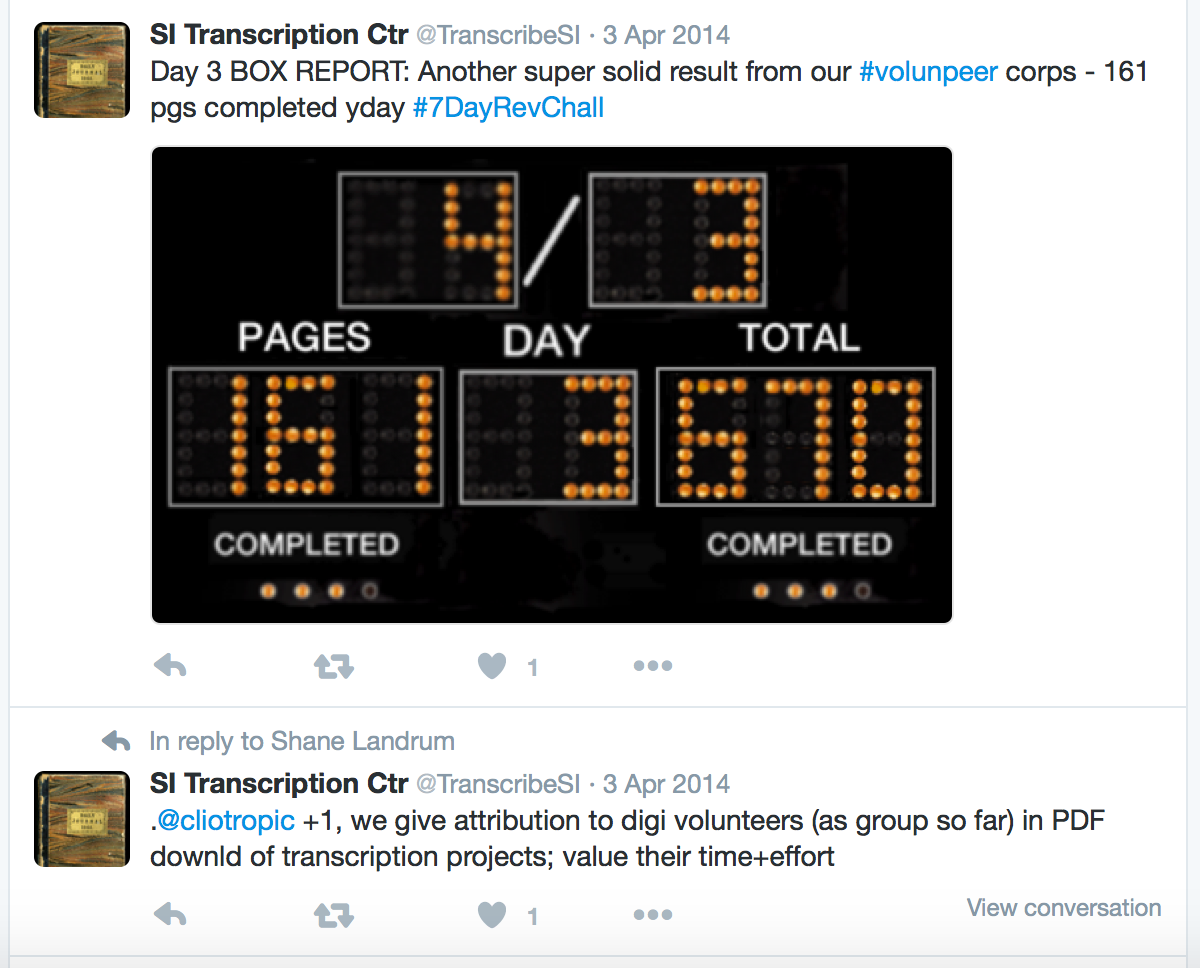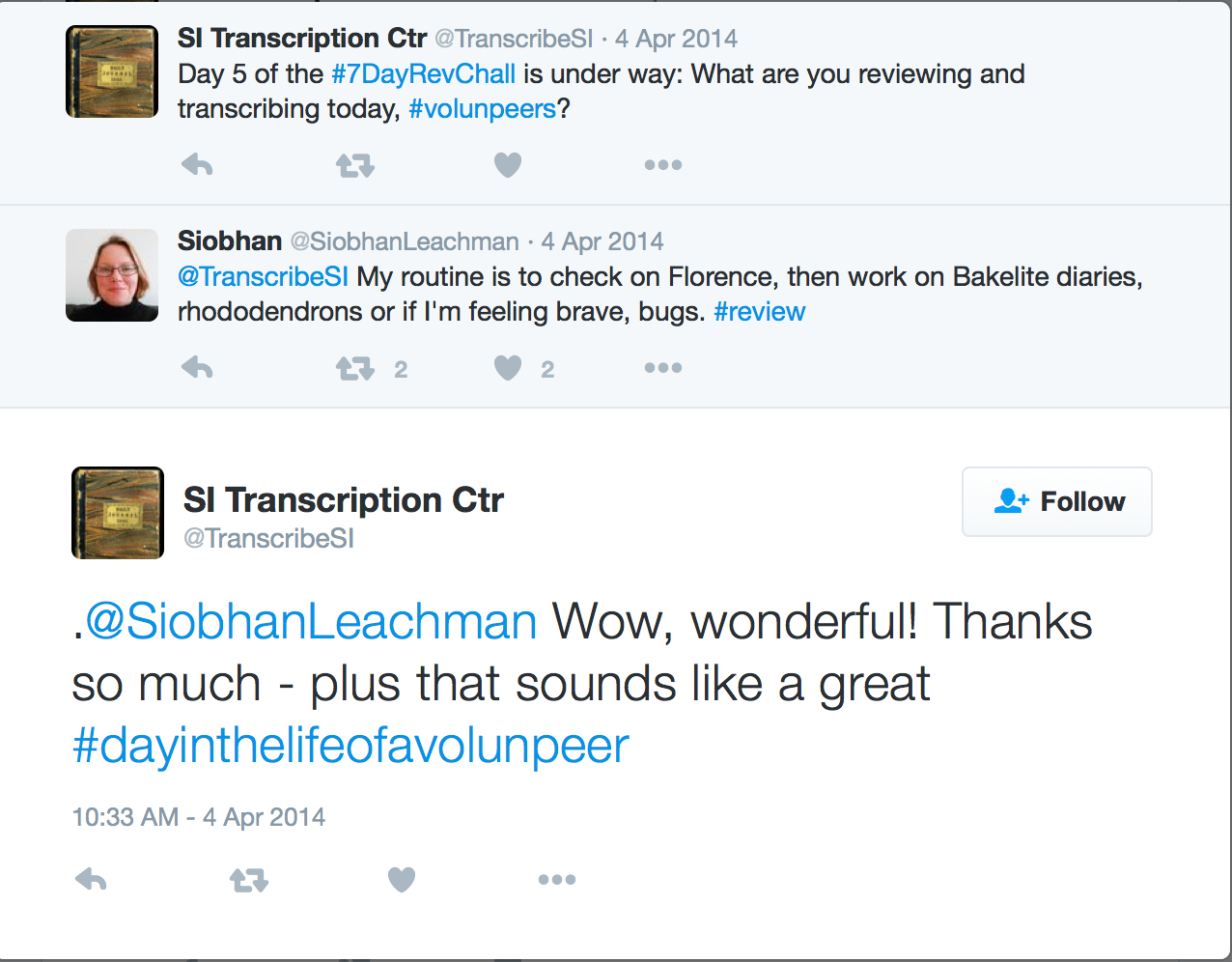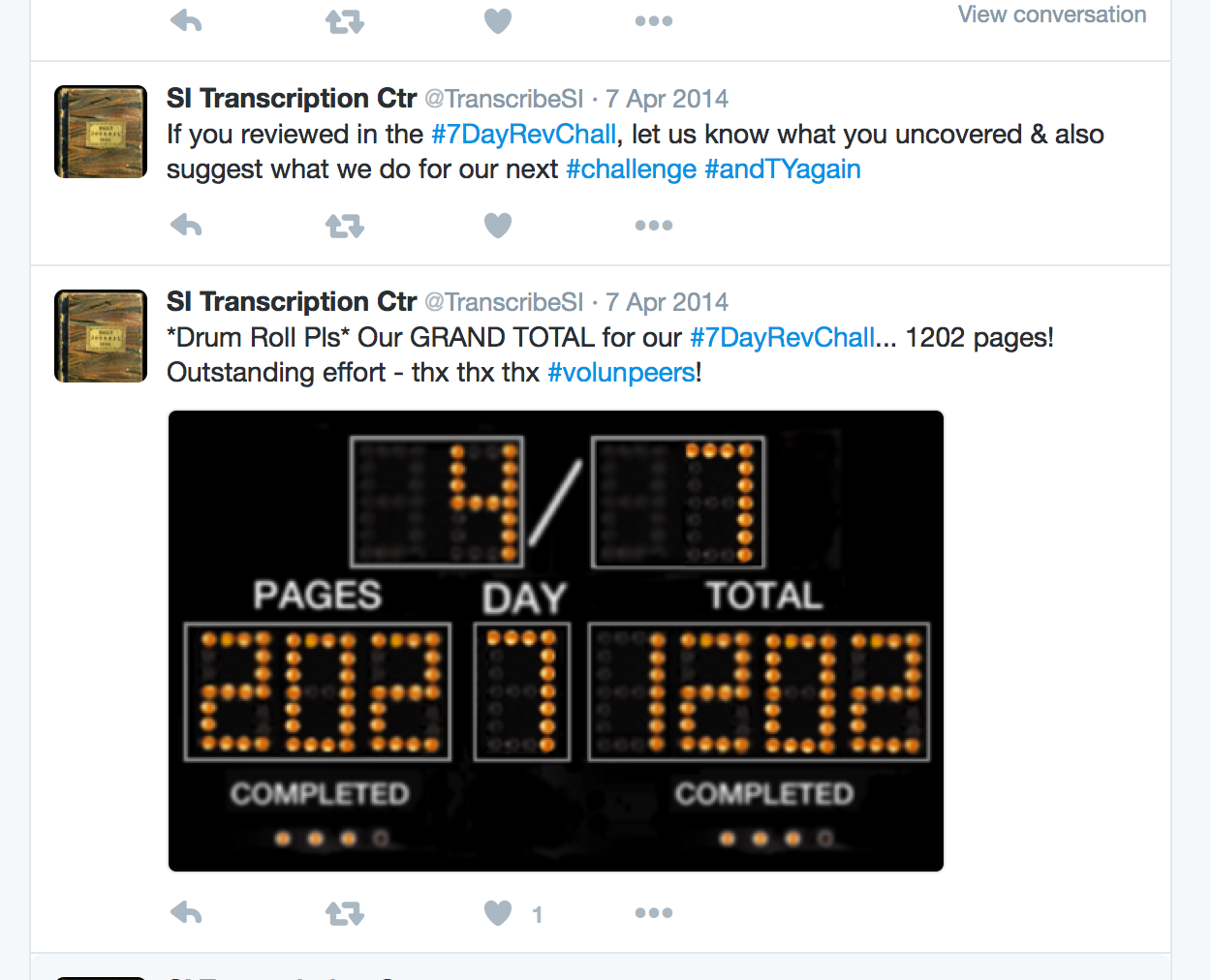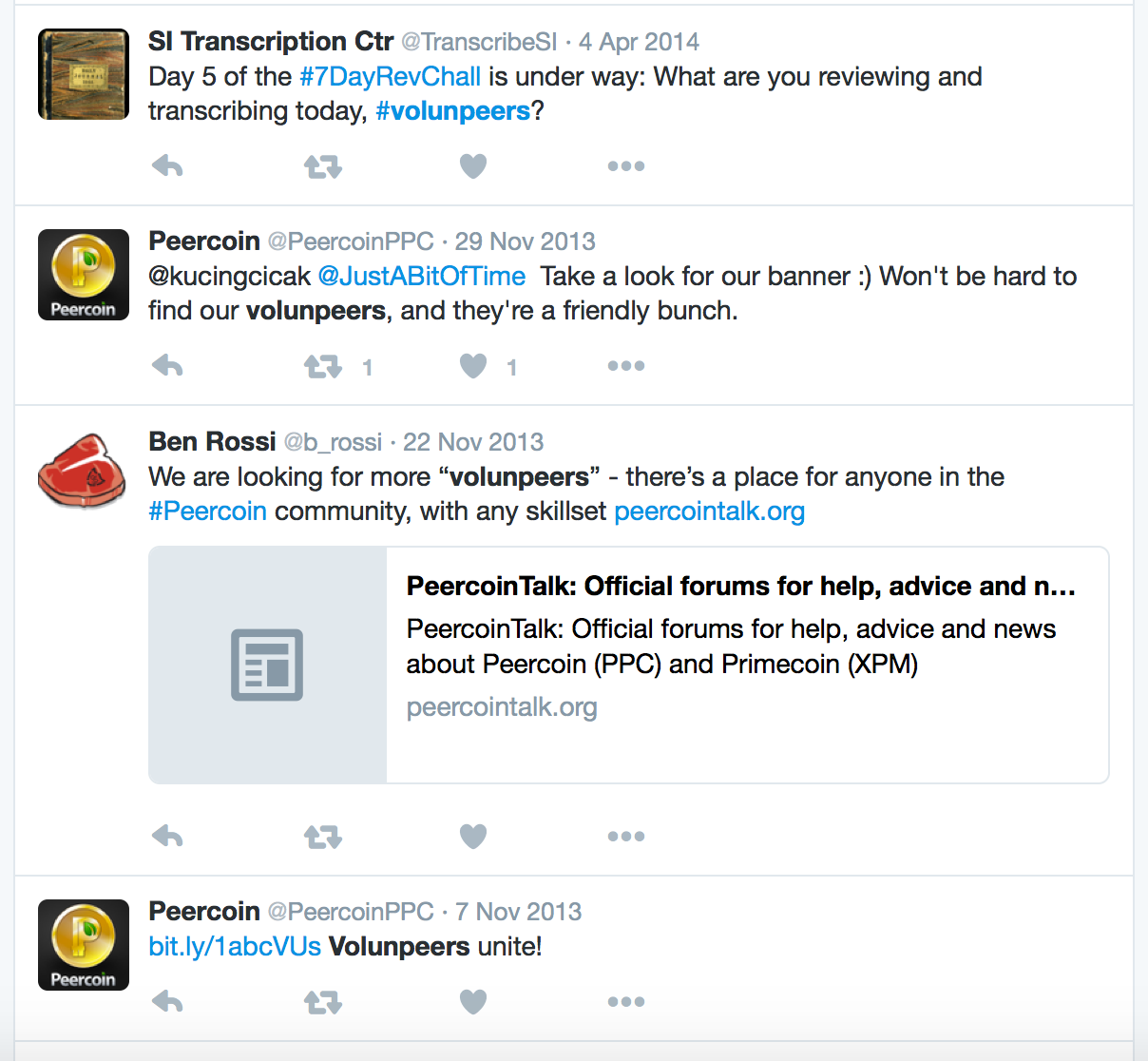Category: Communication
Volunpeers: Hashtag, Identity, & Collaborative Engagement

“Volunpeers” is a flexible term for volunteers, organizations, and institutions to succinctly represent the knowledge-building activities and collaborative enterprise in which they are engaged. When used as a hashtag, #volunpeers can be leveraged to quickly connect individuals to asynchronous collaborative activity. It is a term that may be used to draw novice volunteers into public discussion about crowdsourcing and citizen science activities, as well. It also may be used as a way to announce discoveries and call out for help. “Volunpeers” specifically challenges heirarchical, as well as the exclusivity of, knowledge production and the efforts to created that knowledge; as part of a wider set of activities, it is a term and an identity that may be affiliated with the promise of digital technologies, the internet, and the democratization of knowledge. It is also an identity adopted by participating volunteers to describe themselves and their positioning with this crowdsourcing project of the Smithsonian Transcription Center. This post describes the ways I first implemented the term in coordination with the activities of Smithsonian’s Digital Volunteers and the Smithsonian Transcription Center in April 2014 and its continued use today.
I was several months into my role as project coordinator for the Smithsonian Transcription Center in April 2014, plus a day or two into our second TC 7 Day Review Challenge. I’d issued a goal of reviewing–and ideally completing–as many pages as possible in 7 Days. It was an open, but still formidable task.
Digital volunteers at this point tended to communicate directly with the Transcription Center (i.e. me) via feedback e-mails and tweets. The TC did not and still does not have a discussion board. One drawback of this design decision: some kind of work-around might be necessary when volunteers wanted to bounce ideas or ask others to join them on challenging projects. However, it is also a design decision that creates alternative opportunities for communication between participants – specifically in the social media spaces in which they may already operate.
While responding to a volunteer’s tweets on 01 April 2014 using the @TranscribeSI Twitter handle, I suggested another “volun-peer” might be able to help. In the first 2 days of using these 9 characters, I swiftly incorporated the term “volun-peer”, then “volunpeer”, then the hashtag #volunpeers into the rhetorical approach and central mindset of the TC in three key ways.
In the first use of the hyphenated term, I’m suggesting a portmanteau to blend of meaning of volunteer and peer. This implicitly rejects a hierarchy of volunteers and highlights the peer review and collaboration of the TC.
In the second use, I’m still applying a hyphen but signalling members of the group to an unknown wider set of members while setting out a call-to-action.
In the third use, I continue to use the hyphenated term and this time attempt to catalyze a call to action focused around content: a dapper Leo Baekeland and his diaries.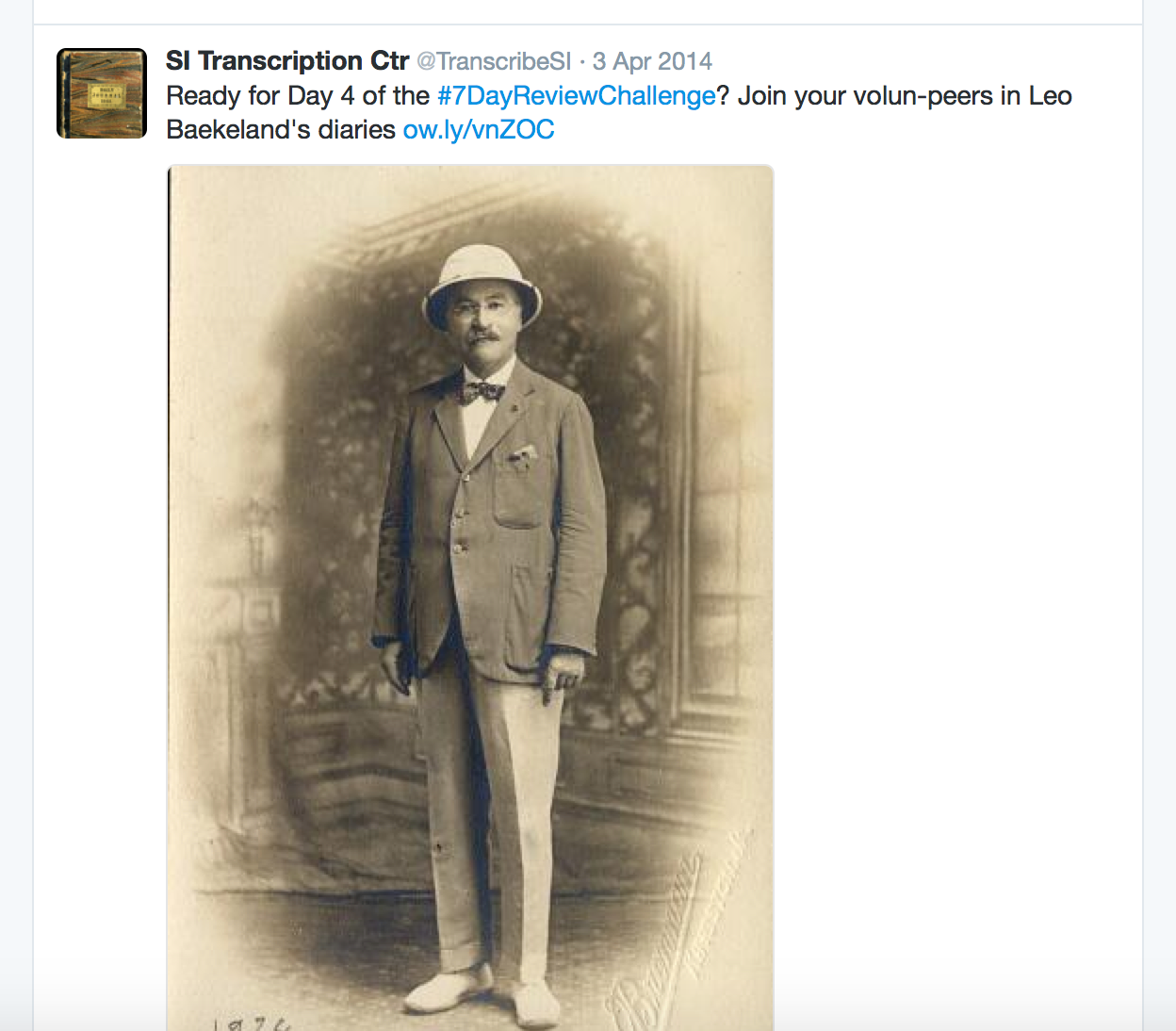
I actually start using a hashtag and non-hyphenated term in the fourth use of volunpeers on 03 April 2014. This first time the hashtag term is singular: #volunpeer. I used it in this way to share the collective contributions of all volunteers engaging with the 7 Day Review Challenge.
Finally, in the 5th use of the term the next day, I use the plural hashtag. In this case, I’m asking questions and trying to generate genuine discussion using this hashtag.
By the 6th, 7th, and 8th uses, the hashtag is allowing me to attach to it messages of encouragement, questions, and report outs. This Grand Total summary below is my 7th use of the term “volunpeers”.
I’m also able by 07 April 2014 to leverage the structural capacity it affords and its discoverability as a hashtag (c.f. Mechant & De Marez, 2012).
In a forthcoming article in a volume of COLLECTIONS: A Journal for Museums and Archives professionals, I describe the ways a hashtag can be a useful string of characters, plus so much more. Specifically, as a hashtag, #volunpeers is employed as a vehicle for conveying information through a social network to the eyes of other willing and interested volunteers.
To summarize myself: the term #volunpeers moves beyond an ascribed label to an adopted identity for those who feel affinity toward its meanings. It also actively incorporates collaborative construction of knowledge. Using #volunpeers chips at barriers and hierarchies of authority between an institution and public through on-going interaction. Staff are learning and improving their workflows through interaction with the public, as well. Rather than telling and directing, #volunpeers can be deployed by the public as well as staff as a means of sharing and inviting productive discussion and inclusion with their work. I use the term to signify the boundaries and the ways they might be blurring, as with collaborative space that uses peer review; and to honor what is possible together rather than what is being done by individuals.
I should note that while @TranscribeSI was the first to use the hashtag #volunpeers, it was used several times in 2013 by a PeerCoin community; and specifically to signal knowledge exchange!
So, what do you make of “volunpeers”? What does it mean to you? Do you think #volunpeers is appropriate, ambitious, or too conservative for crowdsourcing and citizen sceince? Do you consider yourself a volunpeer and if so, why?
Mechant, Peter, and Lieven De Marez. 2012. “Studying Web 2.0 Interactivity: A Research Framework and Two Case Studies.” International Journal of Interactive Communication Systems and Technologies (IJICST) 2, no. 2: 1-18.
CBS This Morning: Up close and Digital

I came across this tweet earlier today and recalled the bit of time I spent with the CBS This Morning team in February 2015.
Hey #volunpeers here's @MeghaninMotion about to give an interview with @CBSThisMorning about @TranscribeSI pic.twitter.com/VYgCjNCAtR
— Sarah Sulick (@sarahtsulick) February 5, 2015
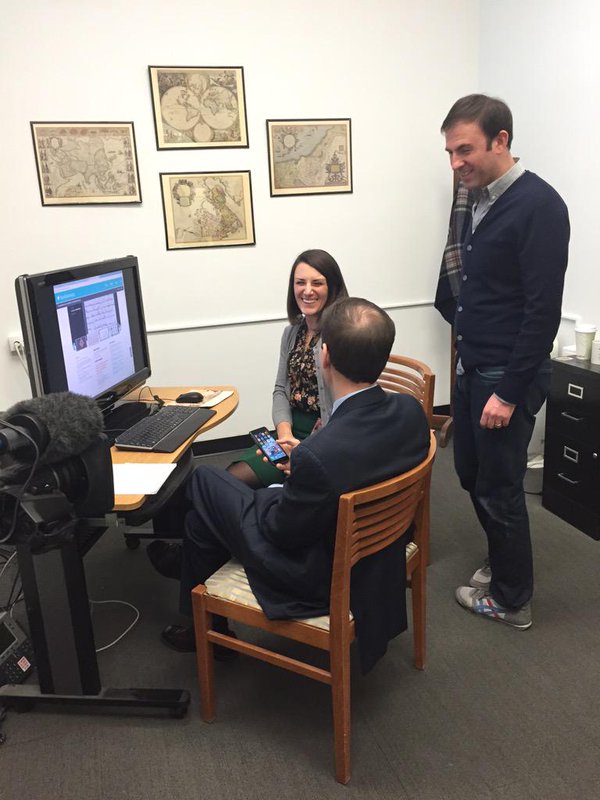 Looks like I forgot to share about this 15 seconds of fame when it happened! In all seriousness, it was a brilliant opportunity to tell a wider audience about the innovative efforts of the Digitization Program Office, the 3D and Digitization teams, and OCIO’s support of Smithsonian Transcription Center.
Looks like I forgot to share about this 15 seconds of fame when it happened! In all seriousness, it was a brilliant opportunity to tell a wider audience about the innovative efforts of the Digitization Program Office, the 3D and Digitization teams, and OCIO’s support of Smithsonian Transcription Center.
So, on that Thursday, at the National Museum of American History, I demonstrated the varying projects in the Smithsonian Transcription Center (TC). Then we checked in on the National Numismatics Collection mass digitization project on the conveyor belt. After that, I chatted on camera for a few minutes with Mark Albert about the promise of crowdsourcing.
Not in the final video edit: I also explained the benefits and potential of making knowledge more accessible in collaborative ways. I described some of our discoveries so far and how the TC fits into other digitization practices at the Smithsonian.
The piece aired on 07 February 2015 as “3D imaging takes Smithsonian from Washington to the world.”
Be sure to watch for an apt reflection on digitization and access from former Digitization Program Office Director Günter Waibel at 3:18 (right before my bumble bee tour). Günter’s final quote closing the clip underscored the ways that these efforts match the vision of James Smithson: “He understood that when information is shared, science gets better.”
I’m looking forward to sharing more updates soon on the ways SI staff, volunteers, and the TC’s mechanisms are increasing the capability for information to be shared easily – and in turn, improve understandings of history, culture, and art, as well as science.
Many Publics, Better Models, & Engaging Volunpeers
For her Nieman Lab fellowship, Melody Kramer interviewed me about my approach to volunteers and community with the Smithsonian Transcription Center.
In her resulting report “Putting the Public into Public Media,” Melody culls insights shared from contexts of many public(inter)facing projects. She puts forth alternative and manageable models for membership. For me, the take-away is to build from a simple but not-so-easy to achieve starting point: ask your public(s) to build with you, have a say in the product they consume, and work with your product to better suit their needs. Together, you can attain more meaningful, deeper, and resilient engagement.
Melody features my approach with the Smithsonian Transcription Center as a case study. In addition, she’s included some of my comments as a footnote. She asked me to detail “how” I build community and engage with our volunteers. Continue reading for my answers to Melody’s question: “How do you foster community?”
“I think I have fostered community by
- being authentic in my engagement (using my voice not hiding behind the Smithsonian, and being enthusiastic because this stuff is pretty cool),
- asking questions that furthered the dialogue (how did you hear about us? what did you think of that? what was most surprising? what would you like to do next?)
- establishing a rhetorical approach that made it clear that we/I was learning at the same time as the volunteers
- establishing a rhetorical approach that suggests there is ALWAYS more to the story and that this is a chance to make discoveries – and then by recognizing or acknowledging those discoveries
- creating the hashtag #volunpeers to allow volunteers to leverage the structure of social media spaces to communicate with one another and with me/us – encouraging them to use it as well to ask for help or indicate a project needs review, etc
- creating collaborative competitions, rather than leaderboarding: #7DayRevChall (7 Day review challenges) allowed people to contribute collectively to a goal, then metric and try to beat the group goal – and using daily updates to share progress. This also allows for skills acquisition and learning best practice for review AND addresses an issue we see frequently – folks love transcribing and pages languish waiting for review. Every 2 months, we draw attention to this
- focusing on the process of transcribing and reviewing often over the volume of the product – and cultivating/encouraging patience from experienced volunteers in regard to “newbies”
- letting volunteers speak to each other directly in spaces in which they already live and are comfortable (Twitter, Facebook, Tumblr) – and we have benefitted from volunteers who are welcoming and want to help each other complete projects
- Also by engaging through those 3 social media networks (also instagram some and hopefully reddit soon), volunteers have the ability to “curate” and own their experience and the product they have created. My perception is that creates more in-depth brand engagement, as well – these volunteers list “digital volunteer for @TranscribeSI” or “#volunpeer for @TranscribeSI” in their bios
- listening to the feedback and description of external interests from volunteers and gauging their excitement in subject matter – then actively courting the archives, museums, and libraries that have related material
- Finally, actually integrating their feedback into site design when(ever) possible”
It seems to me that many of these steps start with two words: curiosity and sharing. In practice, these two words create a cycle of behavior – as you’re curious, you investigate. When you discover, you may want to share so others can learn. When others share, your interests are piqued and you become … more curious. Asking questions, discovering connections, solving challenges, and bringing together people – these all emerge as actions grounded in curiosity and sharing. When I understand that a volunteer has had a lightbulb moment with a project, I try to connect them and this experience to the Smithsonian group that has shared the project. Then staff and public alike are experiencing the moment of discovery – and learning from each other in the process. This often happens in our social media spaces, but I also do this one-on-one with feedback e-mails and questions from our volunteers.
Are you a community manager or are you a volunteer for an organization? How do these approaches relate to your experiences?
Smithsonian Transcription Center: Growing as a Community (Blogpost)
The Smithsonian Transcription Center digital volunteers have grown into a community of volunpeers–collaborators dependent on the work and input of the group–in just over a year.
In this post for Smithsonian Institution Archives’ Bigger Picture blog, I explained a bit about the ways the volunpeers report they use the system and how the peer review process and “eyes per page” can be understand and assessed. I’ll share more about the ways volunpeers learn by doing and how the Transcription Center is a dynamic space in which the process is as important as the product. We continue to learn about our volunpeers’ needs and the ways we can make transcription better.
Liveblogging, Fans, & Learning on Tumblr

Here I talk USWNT fans, multimodal communication, liveblogging, and active moments of learning unfolding in a potentially asynchronous manner on Tumblr in my presentation from NASSS 2013 in Quebec City.
More to follow – a quick review of my posts shows I’m missing FOUR of my presentations on my ethnographic research from the last year. YIKES! #mustcatchup
Until then, have a look at my presentation from November’s North American Society for the Sociology of Sport presentation titled “You Must Be New: Becoming Fans & Communicating Values While Defining International Sport Online.” The presentation unpacks the USWNTvCANWNT rivalry that swelled in the final few minutes of the 03 June 2013 fixture between the two teams. Dubbed “The Rematch,” passions were high for fans of both teams – and dual-nationality player Sydney Leroux’s overtime goal lit the powder keg of incendiary debate that followed.
This discussion focused on the collective fiery learning moment, but future discussion will unpack the racialized and gendered discourses in which Leroux was suspended – with emphasis on nation/nationality, assertions of racism and racist chants, the mediated lens of professional sport, and narrative content – and, of course, being “classy” as an athlete and as fans in-person vs online consumption of sport. Watch this space…

